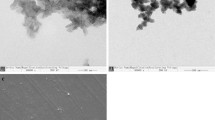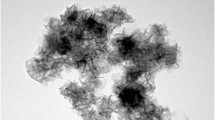Abstract
PMMA/ZnO polymer–ceramic nanocomposite films were fabricated by dispersing zinc oxide (ZnO) nanoparticles up to 10 wt.% into the polymethylmethacrylate (PMMA) using ultrasonic probe sonication and subsequent solution casting. Impedance measurements were performed to determine the frequency-dependent dielectric constant and electrical conductivity of the nanocomposites. Mechanical-to-electrical energy-conversion characteristics of the composites were evaluated by measuring the current and voltage produced under cyclic mechanical loading. The dielectric constant (\({\upvarepsilon }_{{\text{r}}}\)) was found to increase with increasing ZnO content at a frequency of 20 Hz. However, the values of \({\upvarepsilon }_{{\text{r}}}\) decreased monotonically as the frequency increased from 20 to 200 Hz. The dielectric constant of nanocomposites varied from 4.7 for PMMA to 6.9 for 10-wt.% ZnO nanocomposite at 20 Hz. The conductivity of nanocomposites varied from \(5.2 nS{m}^{-1}\) to 7.6 \(nS{m}^{-1}\) in the same range. The maximum average current and voltage output of 10 wt.% ZnO nanocomposites were found to be ~ 24 nA and ~ 4 V, respectively, under the mechanical force of \(2.58\pm 0.01\) N. These results are critical in determining processing–structure–electrical property correlations in PMMA/ZnO nanocomposite films and exhibit the potential for self-powered micro-devices.







Similar content being viewed by others
Data availability
The datasets generated during and/or analyzed during the current study are available from the corresponding author on reasonable request.
References
Aadila A, Asib NAM, Afaah AN, Mohamed R, Rusop M, Khusaimi Z (2013) Structural and optical properties of ZnO/PMMA nanocomposite. Adv Mat Res 832:602–606. https://doi.org/10.4028/www.scientific.net/AMR.832.602
Adarsh A, Kumar B (2020) Wireless medical sensor networks for smart e-healthcare. In: Singh AK, Elhoseny M (eds) Intelligent data security solutions for e-health applications. Academic Press, pp 275–292
Ali U, Karim KJ, Buang NA (2015) A review of the properties and applications of poly (Methyl methacrylate) (PMMA). Polym Rev 55:678–705. https://doi.org/10.1080/15583724.2015.1031377
Aziz A, Asib NAM, Afaah AN, Mohamed R, Rusop M, Khusaimi Z (2014) Structural and optical properties of ZnO/PMMA nanocomposite. Nanoscience nanotechnology and nanoengineering. Trans Tech Publications Ltd, pp 602–606
Briscoe J, Jalai N, Wooliams P, Stewart M, Cain M, Weaver PM, Dunn S (2013) ZnO nanogenerators: energy generation through scavenging vibration, advantages of using a diode. Smart sensors actuators, and MEMS VI. SPIE, p 876308
Çapan I, Tarimci Ç, Hassan AK, Tanrisever T (2009) Characterisation and optical vapour sensing properties of PMMA thin films. Mater Sci Eng, C 29:140–143. https://doi.org/10.1016/j.msec.2008.05.021
Chakraborty H, Sinha A, Mukherjee N, Ray D, Protim Chattopadhyay P (2013) A study on nanoindentation and tribological behaviour of multifunctional ZnO/PMMA nanocomposite. Mater Lett 93:137–140. https://doi.org/10.1016/j.matlet.2012.11.075
Chen X (2020) Introduction. In: Chen X (ed) Randomly deployed wireless sensor networks. Elsevier, pp 1–14
I. Conference, D.M. (2012) July, 2012 IEEE 10th international conference on the properties and applications of dielectric materials July 24–28, 2012, Bangalore, India, 1–4
Drechsler D, Karbach A, Fuchs H (1998) Nanoindentation on polycarbonate/polymethyl methacrylate blends. Appl Phys A 66:S825–S829. https://doi.org/10.1007/s003390051250
Evchuk IYu, Musii RI, Makitra RG, Pristanskii RE (2005) Solubility of polymethyl methacrylate in organic solvents. Russ J Appl Chem 78:1576–1580. https://doi.org/10.1007/s11167-005-0564-9
Ezzat M, Sabiha NA, Izzularab M (2014) Accurate model for computing dielectric constant of dielectric nanocomposites. Applied Nanoscience (switzerland) 4:331–338. https://doi.org/10.1007/s13204-013-0201-5
Fan FR, Tang W, Wang ZL (2016) Flexible nanogenerators for energy harvesting and self-powered electronics. Adv Mater 28:4283–4305. https://doi.org/10.1002/adma.201504299
Gaddam V, Joshi S, Parmar M, Rajanna K, Nayak MM (2012) A novel piezoelectric ZnO nanogenerator on flexible metal alloy substrate. Sensors, 2012 IEEE. IEEE, pp 1–4
Gu L, Liu J, Cui N, Xu Q, Du T, Zhang L, Wang Z, Long C, Qin Y (2020) Enhancing the current density of a piezoelectric nanogenerator using a three-dimensional intercalation electrode. Nat Commun. https://doi.org/10.1038/s41467-020-14846-4
Hu Y, Xu C, Zhang Y, Lin L, Snyder RL, Wang ZL (2011) A nanogenerator for energy harvesting from a rotating tire and its application as a self-powered pressure/speed sensor. Adv Mater 23:4068–4071. https://doi.org/10.1002/adma.201102067
Hussien B, The DC, A.C, (2011) Electrical properties of (PMMA-Al2O3) composites. Euro J Sci Res 52:236–242
Jouglard D, Neyret M, del Campo L, Malki M (2018) Electrical property investigations and microstructure characterization of a nuclear borosilicate glass ceramic. J Nucl Mater 510:27–37. https://doi.org/10.1016/j.jnucmat.2018.07.053
Khan M, Chen M, Wei C, Tao J, Huang N, Qi Z, Li L (2014) Synthesis at the nanoscale of ZnO into poly(methyl methacrylate) and its characterization. Appl Phys A Mater Sci Process 117:1085–1093. https://doi.org/10.1007/s00339-014-8554-5
Kim H, Kim SM, Son H, Kim H, Park B, Ku J, Sohn JI, Im K, Jang JE, Park JJ, Kim O, Cha S, Park YJ (2012) Enhancement of piezoelectricity via electrostatic effects on a textile platform. Energy Environ Sci 5:8932–8936. https://doi.org/10.1039/c2ee22744d
Kobayashi Y, Kurosawa A, Nagao D, Konno M (2009) Fabrication of barium titanate nanoparticles- polymethylmethacrylate composite films and their dielectric properties. Polym Eng Sci 49:1069–1075. https://doi.org/10.1002/pen.21352
Kolekar YD, Sanchez LJ, Ramana CV (2014) Dielectric relaxations and alternating current conductivity in manganese substituted cobalt ferrite. J Appl Phys. https://doi.org/10.1063/14870232
Krishna B, Chaturvedi A, Mishra N, Das K (2018) Nanomechanical characterization of SU8/ZnO nanocomposite films for applications in energy-harvesting microsystems. J Micromech Microeng 28:115013. https://doi.org/10.1088/1361-6439/aae10c
Krishna B, Chaturvedi A, Mishra N, Das K (2021) Quasi-static and dynamic nanomechanical characterization of PMMA/ZnO nanocomposite thick films synthesized by ultrasonication and spin-coating. Polym Polym Compos 29:S229–S238. https://doi.org/10.1177/0967391121998484
Kulyk B, Kapustianyk V, Tsybulskyy V, Krupka O, Sahraoui B (2010) Optical properties of ZnO/PMMA nanocomposite films. J Alloys Compd 502:24–27. https://doi.org/10.1016/j.jallcom.2010.04.162
Kumar B, Kim SW (2012) Energy harvesting based on semiconducting piezoelectric ZnO nanostructures. Nano Energy 1:342–355. https://doi.org/10.1016/j.nanoen.2012.02.001
Kumari S, Mishra RK, Parveen S, Avinashi SK, Hussain A, Kumar S, Banerjee M, Rao J, Kumar R, Gautam RK, Gautam C (2024) Fabrication, structural, and enhanced mechanical behavior of MgO substituted PMMA composites for dental applications. Sci Rep. https://doi.org/10.1038/s41598-024-52202-4
Lee C, Lee S, Sul C, Bae S (1997) Frequency dependence of AC conductivities of KNb1-xVxO3 single crystals. Physica B Condens Matter 239:316–321. https://doi.org/10.1016/S0921-4526(97)00340-2
Li H, Tian C, Deng ZD (2014) Energy harvesting from low frequency applications using piezoelectric materials. Appl Phys Rev. https://doi.org/10.1063/1.4900845
Metin. Demiralp, N.A. Baykara, N.E. Mastorakis, WSEAS (Organization), Advances in microelectronics nanoelectronics and optoelectronics : proceedings of the 8th WSEAS international conference on microelectronics, nanoelectronics, optoelectronics (MINO ’09), Istanbul, Turkey, May 30-June 1, 2009/monograph., WSEAS, 2009
Milton GW (1987) Multicomponent composites, electrical networks and new types of continued fraction I. Commun Math Phys 111:281–327. https://doi.org/10.1007/BF01217763
Olek M, Kempa K, Jurga S, Giersig M (2005) Nanomechanical Properties of silica-coated multiwall carbon nanotubespoly (methyl methacrylate) composites. Langmuir 21:3146–3152. https://doi.org/10.1021/la0470784
Ramesan MT, Nidhisha V, Jayakrishnan P (2017) Synthesis, characterization and conducting properties of novel poly (vinyl cinnamate)/zinc oxide nanocomposites via in situ polymerization. Mater Sci Semicond Process 63:253–260. https://doi.org/10.1016/j.mssp.2017.02.027
Roundy S, Wright PK, Rabaey J (2003) A study of low level vibrations as a power source for wireless sensor nodes. Comput Commun 26:1131–1144. https://doi.org/10.1016/S0140-3664(02)00248-7
Sengwa RJ, Dhatarwal P (2021) Polymer nanocomposites comprising PMMA matrix and ZnO, SnO2, and TiO2 nanofillers: a comparative study of structural, optical, and dielectric properties for multifunctional technological applications. Optical Mater. https://doi.org/10.1016/j.optmat.2021.110837
Soni G, Gouttam N, Soni P (2020) Optical properties of PMMA/ZnO/SiO2 composite thin film. Mater Today Proc 30:35–38. https://doi.org/10.1016/j.matpr.2020.04.027
Supriya S, Kumar S, Kar M (2017) Electrical properties and dipole relaxation behavior of Zinc-substituted cobalt ferrite. J Electron Mater 46:6884–6894. https://doi.org/10.1007/s11664-017-5729-9
Tamboli MS, Palei PK, Patil SS, Kulkarni MV, Maldar NN, Kale BB (2014) Polymethyl methacrylate (PMMA)-bismuth ferrite (BFO) nanocomposite: low loss and high dielectric constant materials with perceptible magnetic properties. Dalton Trans 43:13232–13241. https://doi.org/10.1039/c4dt00947a
Ukhurebor KE, Tyokighir SS, Kerry RG (2020) Wireless sensor networks: applications and challenges. In: Odesanya I (ed) Wireless sensor networks. IntechOpen, Rijeka, p 2
Zheng B, Zhang S, Shu G, Sun Z, Wang Y, Xie J (2023) Experimental investigation and modeling of the mechanical properties of construction PMMA at different temperatures. Structures 57:105091. https://doi.org/10.1016/j.istruc.2023.105091
Acknowledgements
The author acknowledges the primary institution Indian Institute of Technology Bhubaneswar for facilitating the research work.
Funding
No funding was obtained for this study.
Author information
Authors and Affiliations
Contributions
The author confirms sole responsibility for synthesizing the nanocomposites, data collection, analysis and interpretation of results, and manuscript preparation.
Corresponding author
Ethics declarations
Conflict of interest
The authors have no relevant financial or non-financial interest to disclose.
Additional information
Publisher's Note
Springer Nature remains neutral with regard to jurisdictional claims in published maps and institutional affiliations.
Rights and permissions
Springer Nature or its licensor (e.g. a society or other partner) holds exclusive rights to this article under a publishing agreement with the author(s) or other rightsholder(s); author self-archiving of the accepted manuscript version of this article is solely governed by the terms of such publishing agreement and applicable law.
About this article
Cite this article
Krishna, B., Kumar, J. & Shukla, P.K. Processing, microstructure, and electrical properties of PMMA/ZnO nanocomposite films for prospective energy-conversion applications. Multiscale and Multidiscip. Model. Exp. and Des. (2024). https://doi.org/10.1007/s41939-024-00438-y
Received:
Accepted:
Published:
DOI: https://doi.org/10.1007/s41939-024-00438-y




